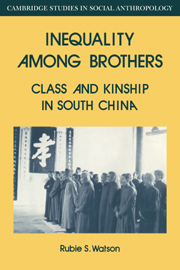Book contents
- Frontmatter
- Contents
- Preface
- Maps
- 1 Introduction
- 2 The development of the Teng lineage: Ha Tsuen's early history
- 3 Lineage organization and ideology
- 4 Economic organization: the land and the market
- 5 Local political organization
- 6 Class differences in Ha Tsuen: the social and cultural dimension
- 7 Marriage, affinity, and class
- 8 Economic and political changes: 1945–1978
- 9 Social and cultural transformations
- 10 Class and kinship
- References
- Glossary
- Index
- CAMBRIDGE STUDIES IN SOCIAL ANTHROPOLOGY
- Frontmatter
- Contents
- Preface
- Maps
- 1 Introduction
- 2 The development of the Teng lineage: Ha Tsuen's early history
- 3 Lineage organization and ideology
- 4 Economic organization: the land and the market
- 5 Local political organization
- 6 Class differences in Ha Tsuen: the social and cultural dimension
- 7 Marriage, affinity, and class
- 8 Economic and political changes: 1945–1978
- 9 Social and cultural transformations
- 10 Class and kinship
- References
- Glossary
- Index
- CAMBRIDGE STUDIES IN SOCIAL ANTHROPOLOGY
Summary
The hamlet of Sik Kong Wai is situated in the extreme northwestern section of Hong Kong's New Territories. The hamlet is centuries old, and like many rural communities in southeastern China, Sik Kong Wai is walled (wai in fact, means “enclosure”). The hamlet's stout brick walls (15 feet high and 2 feet thick) were built to withstand bandit attacks and jealous neighbors; they still serve to discourage the casual visitor. The only entrance to the hamlet is through a massive wooden gate set in the western wall. Just inside the gate is a small anteroom that houses the shrine of a local god. This “god of the gate” has the responsibility of guarding hamlet residents against dangerous outsiders, both human and supernatural. Near the shrine is a stone bench worn smooth from centuries of daily use by the hamlet's other guardians. Every afternoon Sik Kong Wai's elderly women gather at the gate to talk, smoke, and watch over grandchildren. Little happens in Sik Kong Wai that is not observed by the hamlet's temporal gatekeepers.
Once inside the hamlet walls, the visitor is confronted by row after row of small gray brick houses. The doors of these houses open directly onto narrow stone paths that link the rows of houses to a central avenue – itself only 5 feet wide. Most of the houses measure about 15 feet by 8 feet and are divided into two rooms.
- Type
- Chapter
- Information
- Inequality Among BrothersClass and Kinship in South China, pp. 1 - 11Publisher: Cambridge University PressPrint publication year: 1985

